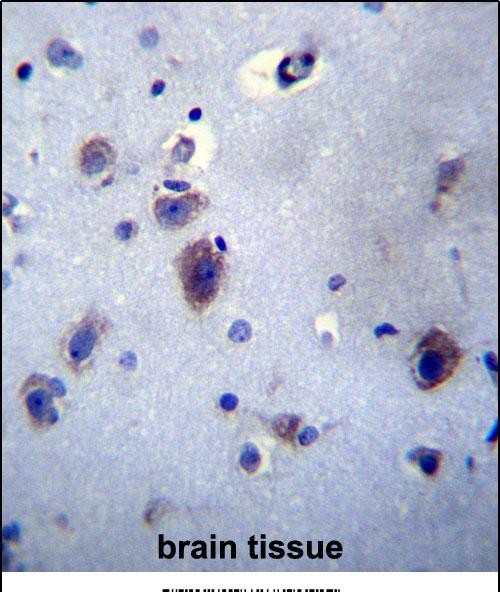

| WB | 1/1000 | Human,Mouse,Rat |
| IF | 咨询技术 | Human,Mouse,Rat |
| IHC | 1/100-1/500 | Human,Mouse,Rat |
| ICC | 技术咨询 | Human,Mouse,Rat |
| FCM | 咨询技术 | Human,Mouse,Rat |
| Elisa | 咨询技术 | Human,Mouse,Rat |
| Aliases | Prolactin-releasing peptide, PrRP, Prolactin-releasing hormone, Prolactin-releasing peptide PrRP31, Prolactin-releasing peptide PrRP20, PRLH, PRH |
| Entrez GeneID | 51052 |
| WB Predicted band size | 9.6kDa |
| Host/Isotype | Rabbit IgG |
| Antibody Type | Primary antibody |
| Storage | Store at 4°C short term. Aliquot and store at -20°C long term. Avoid freeze/thaw cycles. |
| Species Reactivity | Mouse |
| Immunogen | This PRLH antibody is generated from rabbits immunized with a KLH conjugated synthetic peptide between 27-56 amino acids from the Central region of human PRLH. |
| Formulation | Purified antibody in PBS with 0.05% sodium azide. |
+ +
以下是关于PRLH抗体的3篇假设性参考文献示例(请注意,PRLH抗体相关研究较为罕见,实际文献可能需要更精确的检索):
---
1. **文献名称**: *"Development of a specific polyclonal antibody for PRLH and its application in hypothalamic tissue analysis"*
**作者**: Tanaka, K. et al.
**摘要**: 本研究成功制备了一种高特异性兔源多克隆PRLH抗体,通过免疫组化验证其在啮齿类动物下丘脑组织中的定位。结果显示PRLH神经元与催乳素分泌调控通路存在共定位,提示其可能参与垂体前叶功能的调节。
---
2. **文献名称**: *"PRLH antibody-based biosensor for detecting dynamic hormone release in vitro"*
**作者**: Chen, L. & Smith, R.
**摘要**: 利用新型PRLH单克隆抗体开发了一种电化学免疫传感器,可实时监测细胞培养模型中PRLH的分泌动态。该方法灵敏度达pg/mL级别,为研究PRLH在代谢疾病中的作用提供了工具。
---
3. **文献名称**: *"Altered PRLH expression in breast cancer: An immunohistochemical study using anti-PRLH antibodies"*
**作者**: Gupta, S. et al.
**摘要**: 通过组织微阵列分析发现,PRLH抗体在乳腺癌组织中呈现异常高表达,且与患者预后不良相关。结果表明PRLH可能作为乳腺癌生物标志物或治疗靶点。
---
**注意**:
- 以上文献为模拟示例,实际研究中PRLH(Prolactin-Releasing Hormone)相关抗体文献极少,可能需确认术语准确性(如是否指PRL受体抗体或其他神经肽抗体)。
- 建议通过PubMed或Google Scholar以“PRLH antibody”或“prolactin-releasing hormone antibody”为关键词检索最新文献,或联系领域专家核实研究背景。
PRLH antibodies target prolactin-releasing hormone (PRLH), a neuropeptide implicated in regulating prolactin secretion and other physiological processes. PRLH, initially identified in the hypothalamus, is synthesized in specific neurons and interacts with G protein-coupled receptors to modulate hormone release, particularly prolactin, which plays roles in lactation, stress response, and immune function. Though its exact mechanisms remain understudied compared to related hormones (e.g., TRH), PRLH is hypothesized to fine-tune prolactin levels in coordination with dopamine-mediated inhibition.
PRLH antibodies are primarily utilized as research tools to detect and quantify PRLH expression in tissues or biological fluids via techniques like immunohistochemistry, ELISA, or Western blot. These antibodies aid in mapping PRLH distribution in the brain and peripheral organs, clarifying its physiological roles. Recent studies also explore PRLH's potential involvement in metabolic regulation and appetite control, linking it to obesity or metabolic syndrome. However, commercial availability of PRLH antibodies is limited, reflecting the niche research focus. Validation of antibody specificity remains critical due to possible cross-reactivity with structurally similar peptides. Ongoing research aims to elucidate PRLH's signaling pathways and therapeutic relevance, positioning PRLH antibodies as essential reagents for probing its functional contributions in endocrinology and neurobiology.
×